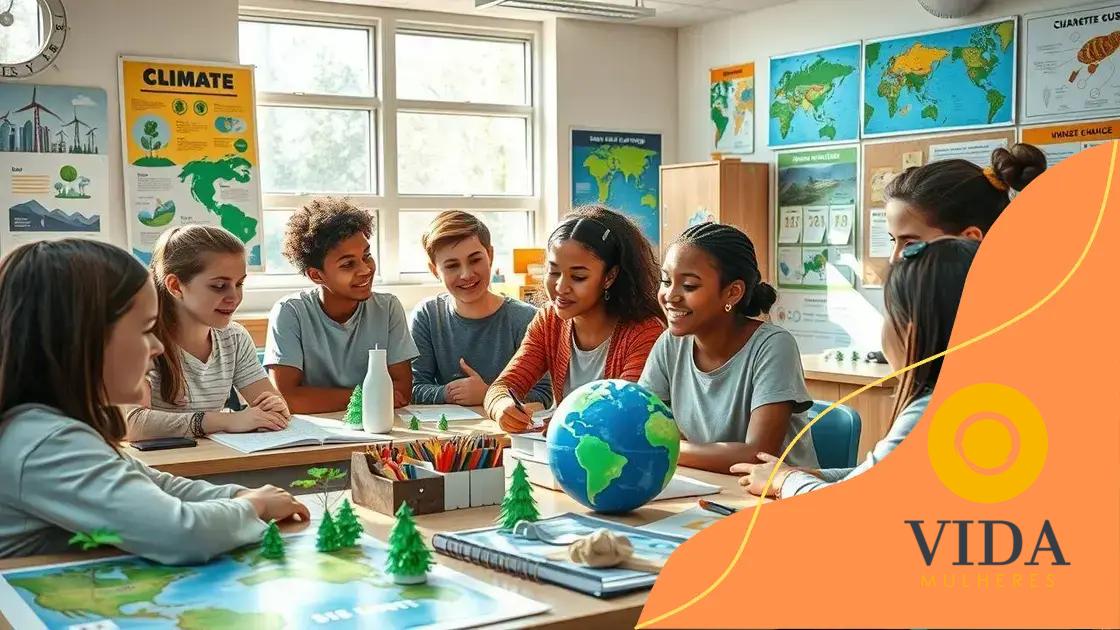Climate education mandates proposed in school districts

Climate education mandates in school districts require the integration of climate change topics into curricula, enhancing student awareness and promoting sustainable practices within communities.
Climate education mandates proposed in school districts are gaining traction as a vital part of modern curricula.
But why is this becoming a priority for districts? Let’s explore the benefits and implications of these changes.
Understanding climate education and its importance
Understanding climate education is crucial for preparing young minds to tackle one of the most pressing challenges of our time.
By integrating climate issues into school curricula, educators empower students with the knowledge they need to make informed decisions about the environment.
This form of education fosters awareness of the impacts of climate change on our planet. It encourages students to think critically about sustainability and their roles in protecting the Earth.
As climate education evolves, schools across the country are adopting various methods to engage students.
Key Components of Climate Education
Climate education programs typically include interactive elements that keep students interested and focused. Here are some key components:
- Understanding the science behind climate change
- Exploring local environmental issues
- Encouraging community involvement in sustainability projects
Additionally, these programs often highlight the importance of lifestyle changes that can mitigate climate change.
Engaging students in hands-on activities, such as gardening or recycling, cements the lessons they learn in the classroom.
Benefits of Climate Education
There are numerous benefits to implementing climate education in schools. It not only informs students about important environmental issues but also:
- Instills a sense of responsibility towards the planet
- Encourages critical thinking and problem-solving skills
- Fosters teamwork through collaborative projects
By encouraging a connection to the environment, climate education helps students become champions for environmental justice.
As they learn about the impacts of climate change, they develop a passion for creating a sustainable future. In doing so, they not only learn the science but also gain the tools to advocate for change in their communities.
Overall, embracing climate education is vital for students, enabling them to navigate the complex challenges posed by a changing world.
As future leaders, these students will be equipped to address climate issues head-on, ensuring a healthier planet for generations to come.
Recent trends in climate education mandates

Recent trends in climate education mandates are reshaping how schools approach environmental issues.
More school districts are recognizing the need to include climate literacy as a core component of their curricula. This shift empowers students with the skills to understand and address climate challenges.
One notable trend is the integration of climate education across all subjects. Rather than teaching climate issues in isolation, educators are embedding these topics into science, social studies, and even art classes.
This approach helps students see the interconnectedness of climate change with various aspects of life.
Innovative Teaching Methods
As districts implement new mandates, they are adopting innovative teaching methods. These methods engage students and make learning fun. Here are some key approaches:
- Experiential learning through hands-on projects
- Using technology to connect with global climate initiatives
- Collaborative learning by partnering with local environmental organizations
Such methods not only make classes more engaging but also help students apply their learning in real-world situations.
For instance, participating in community clean-up events allows students to experience the impact of their actions.
Partnerships for Progress
Another trend is the growing partnerships between schools and environmental organizations. These collaborations offer resources and support for schools.
By working together, educators and organizations can create comprehensive programs that enhance students’ learning experiences.
Additionally, many states are developing guidelines that promote climate literacy. These guidelines specify learning outcomes and resources that schools can use to meet new mandates.
As a result, teachers feel more supported in delivering effective climate education.
As we look at the evolving landscape of climate education mandates, it’s clear that these trends are paving the way for a more environmentally conscious generation.
School districts are stepping up to provide students with the necessary tools to understand and act on climate issues.
How school districts are implementing these mandates
School districts are making significant strides in implementing climate education mandates. These efforts are critical, as they determine how effectively students learn about climate change and sustainability.
Many districts are adopting innovative strategies to ensure climate education is part of everyday learning.
One common approach is to train teachers on the latest climate science and teaching methods.
Districts are investing in professional development programs that focus on enhancing educators’ understanding of climate issues.
This ensures that teachers have the knowledge and resources they need to engage students effectively.
Curriculum Integration
Another important method is integrating climate education into existing subjects. Schools start by revising their curricula to include climate topics across various disciplines.
For example, science classes may cover the scientific principles behind climate change, while social studies might explore the social impact of environmental policies.
- Science teachers explain carbon emissions and their effects.
- Math classes incorporate data analysis related to climate statistics.
- Art programs encourage creative projects that highlight environmental themes.
This holistic approach helps students see the relevance of climate issues in their daily lives. Furthermore, many districts are forming partnerships with local organizations to provide hands-on learning experiences.
These partnerships often lead to community projects, where students can apply what they’ve learned.
Community Involvement
Encouraging community involvement is another key strategy. School districts are engaging parents and local organizations in climate education initiatives.
Community forums and workshops are hosted to discuss climate issues and share ideas for sustainability initiatives.
These events not only educate families but also create a support network for students.
When students see their families participating in climate actions, they are more likely to adopt environmentally friendly habits.
Districts are also promoting student-led initiatives, such as recycling programs or tree-planting events, to foster a sense of ownership and responsibility.
Through these varied strategies, schools are making climate education a vital part of the learning experience.
By focusing on teacher training, curriculum integration, and community involvement, school districts are effectively preparing students to tackle climate challenges.
Challenges faced by educators in climate teaching

Educators face several challenges in teaching about climate change and sustainability. While they are motivated to inform and engage students, various obstacles can hinder effective climate education.
These challenges include resource limitations, knowledge gaps, and resistance to curriculum changes.
One of the primary issues is the lack of adequate resources. Many schools struggle with funding, which can limit access to up-to-date materials and technology necessary for teaching climate concepts.
Without the right tools, teachers find it difficult to present information in engaging and impactful ways.
Knowledge Gaps Among Educators
Another challenge is the knowledge gap among educators themselves. Not all teachers feel confident discussing climate change, especially if they don’t have a strong background in environmental science.
Professional development programs often focus on curriculum changes but may not provide enough training in the scientific content.
- Teachers may fear providing incorrect information.
- Inadequate support leads to inconsistent teaching.
- Teachers might feel unprepared to answer students’ questions.
This inconsistency can affect how students perceive climate issues. If educators are unsure, students may not receive a comprehensive view of the science behind climate change and its implications.
Resistance and Curriculum Changes
Resistance to implementing new curriculum standards also poses a significant challenge. Some parents and community members may question the relevance of climate education, while others may not agree with the approaches being taught.
This creates tension between educators and the community regarding what should be included in education.
Additionally, existing curriculums are often rigid. Teachers might struggle to incorporate climate topics into subjects that traditionally do not cover these issues, such as mathematics or literature.
This can lead to the perception that climate education is an add-on rather than an essential part of learning.
Overall, these challenges highlight the need for ongoing support and training for educators.
By addressing resource limitations, enhancing teacher training, and fostering community support, we can improve climate education in schools. This will help equip students with the knowledge and skills necessary to understand and address climate challenges in their lives.
The impact of climate education on student awareness
The impact of climate education on student awareness is profound and far-reaching. When students learn about climate change, they become more informed about the challenges facing our planet.
This increased awareness can lead to positive changes in behavior and attitudes toward the environment.
One significant effect is the development of critical thinking skills. As students explore complex topics like climate science, they learn to evaluate information and understand different viewpoints.
This ability is valuable not only in understanding climate issues but also in becoming engaged citizens.
Changes in Behavior
Students exposed to climate education often show a change in their behaviors and habits. They are more likely to:
- Participate in recycling and waste reduction programs.
- Advocate for sustainable practices in their communities.
- Engage in activities like tree planting and conservation efforts.
These actions demonstrate a commitment to environmental stewardship, and students often encourage their families and peers to adopt similar practices.
This ripple effect can lead to significant community improvements in sustainability.
Enhanced Engagement in Environmental Issues
Moreover, climate education fosters a sense of responsibility. Students begin to see themselves as part of the solution to environmental problems.
They feel empowered to advocate for policies addressing climate change. Many schools also incorporate service-learning projects that link classroom knowledge with real-world application.
When students contribute to community-based environmental projects, they gain firsthand experience in tackling climate issues.
This experiential learning emphasizes the relevance of their education, making them more likely to stay engaged with environmental issues in the future.
As students share what they learn about climate change with friends and family, they raise awareness beyond the classroom.
This peer-to-peer education helps to spread knowledge about climate science and sustainability practices, creating a more informed society.
In conclusion, climate education plays a vital role in shaping student awareness and behavior. By integrating climate topics into school curriculums, students not only learn about the critical challenges our planet faces but also develop the skills and motivation to make a difference.
As they participate in projects and discussions, they become advocates for sustainability within their communities. The ripple effects of this education can lead to lasting changes in how future generations interact with the environment.
FAQ – Frequently Asked Questions about Climate Education
What are climate education mandates?
Climate education mandates are guidelines set by school districts requiring the inclusion of climate change topics in school curriculums to foster student awareness.
How does climate education impact student behavior?
Climate education encourages students to adopt sustainable practices, such as recycling and conservation efforts, leading to a positive environmental impact.
What challenges do teachers face in climate education?
Teachers often encounter challenges like limited resources, knowledge gaps, and resistance from the community, which can hinder effective climate teaching.
Why is student engagement important in climate education?
Engaged students are more likely to become advocates for sustainability and contribute to community efforts, spreading awareness beyond the classroom.






